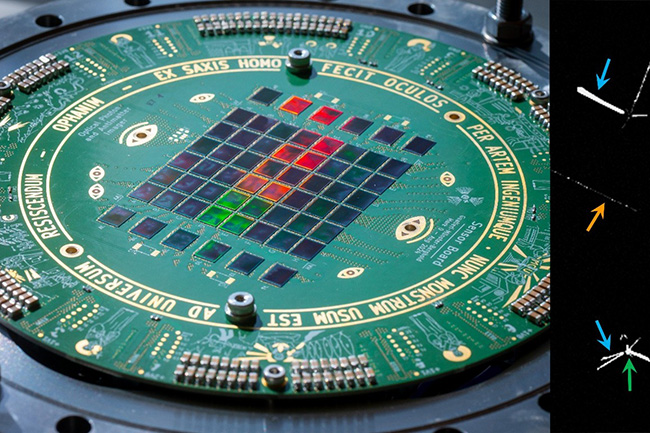AEgIS transforms smartphone sensors into an unprecedented resolution antimatter camera

Did you know that the camera sensor in your smartphone could help unlock the secrets of antimatter? Scientists working together in the “Antihydrogen Experiment: Gravity, Interferometry, Spectroscopy” (AEgIS), a key experiment in the AVA network, developed a detector using modified mobile camera sensors to track in real time the points where antimatter annihilates with matter. This new device, described in a paper just published in Science Advances, can pinpoint antiproton annihilations with a resolution of about 0.6 micrometres, a 35-fold improvement over previous real-time methods.
AEgIS and other experiments at CERN’s Antimatter Factory, such ALPHA and GBAR, are on a mission to measure the free-fall of antihydrogen under Earth's gravity with high precision, each using a different technique. AEgIS’s approach involves producing a horizontal beam of antihydrogen and measuring its vertical displacement using a device called a moiré deflectometer that reveals tiny deviations in motion and a detector that records the antihydrogen annihilation points.
“For AEgIS to work, we need a detector with incredibly high spatial resolution, and mobile camera sensors have pixels smaller than 1 micrometer,” says Francesco Guatieri from the research neutron source FRM II at TUM and Principal Investigator of the research. “We have integrated 60 of them in the single photographic detector, the Optical Photon and Antimatter Imager (OPHANIM), with the highest number of pixels currently operational: 3840 MPixels. Previously, photographic plates were the only option, but they lacked real-time capabilities. Our solution, demonstrated for antiprotons and directly applicable to antihydrogen, combines photographic-plate-level resolution, real-time diagnostics, self-calibration and a good particle collection surface, all in one device.”
Specifically, the researchers used Sony optical image sensors that had previously been shown to be capable of imaging low-energy positrons in real time with unprecedented resolution.“We had to strip away the first layers of the sensors, which are made to deal with the advanced integrated electronics of mobile phones,” says Guatieri. “This required high-level electronic design and micro-engineering.”
“This is a game-changing technology for the observation of the tiny shifts due to gravity in an antihydrogen beam travelling horizontally, and it can also find broader applications in experiments where high position resolution is crucial, or to develop high-resolution trackers.” says AEgIS spokesperson Ruggero Caravita. “This extraordinary resolution enables us also to distinguish between different annihilation fragments, paving the way for new research on low-energy antiparticle annihilation in materials,” concludes Caravita.
Indeed, annihilations appear as star-shaped events with multiple tracks emanating from one primary vertex. Green, cyan and orange arrows indicate examples of nuclear fragments, protons, and pions.

The Optical Photon and Antimatter Imager, integrating 60 sensors, and some examples of antiproton annihilations obtained with it. Credit: AEgIS/CERN.
A key factor in achieving the record precision was an unexpected element: crowdsourcing. “We found that human intuition currently outperforms automated methods”, says Guatieri. The AEgIS team asked their colleagues to manually determine the position of the antiproton annihilation points in each of the more than 2,500 detector images, a procedure that turned out to be far more accurate and precise than any algorithm. The only downside: it took up to 10 hours for each colleague to plough through every annihilation event.
More information: https://www.science.org/doi/10.1126/sciadv.ads1176
Credit: AEgIS/CERN